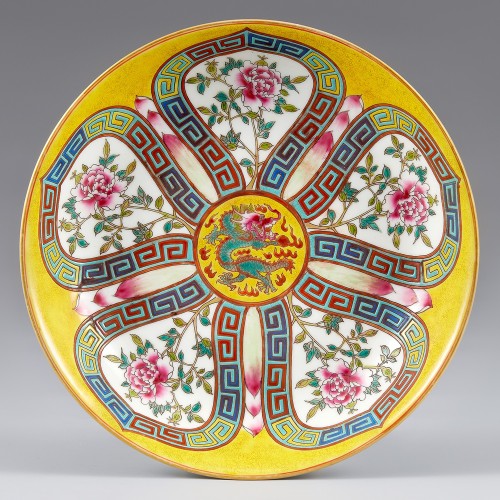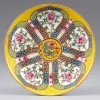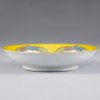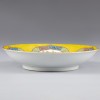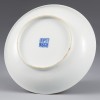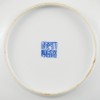작품 정보
분채(粉彩) 기법으로 제작된 황실용 접시로, 노란 유약 바탕 위에 정교하면서도 절제된 문양 구성이 돋보입니다. 접시 중앙에는 작은 원 안에 용이 묘사되어 있으며, 주변은 다섯 개의 방사형 구획으로 나뉘어 각각 모란과 연꽃 문양으로 채워져 있습니다. 각 구획은 기하학적인 뇌문(雷紋)으로 둘러져 있는데, 이는 수호와 영속성을 상징합니다.
모란은 중국에서 부귀(富貴)와 영광의 상징으로 여겨지며, 특히 여성적인 아름다움과 연결되어 황실 여성의 궁중 기물에 자주 등장합니다. 접시 전체는 꽃잎이 퍼진 형태로 구성되어 있어, 연꽃 혹은 연화좌를 연상시키는 불교적 상징으로도 해석됩니다. 중앙의 용은 네 발을 가진 오조룡(五爪龍)으로, 황제를 상징하는 전용 문양입니다. 이 용은 화염 속을 날며 우주의 중심을 수호하는 존재로 형상화되었으며, 한 발에는 여의주를 쥔 모습으로 묘사되어 황제의 절대 권위를 상징합니다. 중앙의 용은 황제를, 주변의 모란은 후궁 또는 황실 여성의 미덕과 위엄을 상징하며, 이러한 상징적 조화는 단순한 장식 기물을 넘어 권력의 표상이자 국가적 미의식을 담은 표현으로 이해할 수 있습니다. 이러한 점에서, 이 접시는 황족 또는 고위 귀족을 위한 부장품이었을 것으로 추정됩니다.
또한 이 접시에는 건륭제 시기에 절정을 이룬 분채 도자기 기법이 적용되어 색채가 부드럽고 섬세하며, 은은한 반투명감을 자아냅니다. 또렷한 윤곽선과 유려한 채색의 조화는 건륭제 시기 관요 도자의 전형적인 특징입니다. 규칙적인 테두리 문양과 유기적인 꽃가지, 그리고 중앙의 용이 이루는 강렬한 대비는 뛰어난 시각적 균형을 형성합니다. 접시 바닥 면에는 ‘대청건륭년제(大清乾隆年製)’라는 관지가 있어, 이 유물이 건륭제 시기에 제작되었음을 보여줍니다.
이처럼 이 접시는 청대 황실 도자기의 형식미, 상징체계, 그리고 기술적 완성도를 집약한 것이라 할 수 있습니다. 특히 건륭제 시기의 분채 도자기는 기술적 정교함은 물론 예술성 또한 뛰어나, 오늘날 세계 주요 박물관의 중국 도자기 컬렉션에서도 주요 유물로 전시되고 있습니다.
━━━━━
该盘采用粉彩技法绘制,为皇室御用瓷器。以黄色釉料为底,图案设计繁复而又节制与平衡,极具特色。盘面中央绘有一条龙,位于一个小圆内;五个开光内分别绘有牡丹纹和莲花纹。开光带状外框内环绕几何形的雷纹,象征守护与永恒。
牡丹在中国传统文化中象征富贵与荣耀,常与女性之美相结合,因此频繁出现在皇室女性所用的器物中。如花瓣般展开的造型似莲花或莲花座,蕴含佛教象征意义。中央所绘之龙为四足五爪龙,象征皇帝。该龙于火焰之中腾跃,被形象化为守护宇宙中心的存在,并以一爪握有如意珠,象征皇权的至高无上。中央的龙代表皇帝,而周围的牡丹则象征后宫女性的美德与威仪,整体的象征组合不仅是一件宫廷器物,更体现为权力的象征与国家审美认同的具现。该盘反映皇室威严,推测为皇族或贵族的随葬品。
此外,该瓷盘采用乾隆时期完成度极高的粉彩工艺,色彩柔和细腻,呈现出半透明的光感。清晰的轮廓线与流畅的彩绘相辅相成,是乾隆时期官窑瓷器的典型特征。规则的边饰图案、花枝、与龙的强烈形象对比鲜明,营造出卓越的视觉平衡感。盘底足署“大清乾隆年制 ”六字款识,可知其为乾隆时期所制。
综上所述,此瓷盘是清代皇室审美、象征体系与高度工艺集于一身的瓷器杰作。乾隆年间的粉彩瓷器不仅工艺成熟,艺术高雅,至今在世界各大博物馆的中国陶瓷收藏中占据重要地位。
━━━━━
This imperial dish, produced using the famille rose technique, features a refined yet restrained design rendered over a vibrant yellow glaze. At the center of the dish, a dragon is depicted within a small medallion, surrounded by five radiating sections, each filled with alternating motifs of peonies and lotus flowers. These compartments are framed by thunder pattern borders, which symbolize protection and permanence.
In Chinese culture, the peony symbolizes wealth and honor and is especially associated with feminine beauty, making it a frequent motif on palace wares used by imperial women. The dish’s petal-like form evokes a lotus or lotus pedestal, suggesting Buddhist symbolism. At the center is a five-clawed dragon with four legs, an emblem reserved exclusively for the emperor. The dragon, shown soaring through flames and grasping a wish-granting jewel, represents the emperor's supreme authority and his role as the cosmic guardian. The central dragon stands for the emperor himself, while the surrounding peonies symbolize the virtues and dignity of imperial consorts and women of the court. This symbolic interplay elevates the dish beyond decorative use, reflecting power, court hierarchy, and national aesthetics. Given its rich symbolism and craftsmanship, the dish was likely created as a burial object or ceremonial item for royalty or high-ranking aristocrats.
Moreover, the dish exemplifies the technical and artistic sophistication of famille rose porcelain at its height during the Qianlong reign. The colors are soft and delicate, with a subtle translucency, and the composition achieves a harmonious balance between bold outlines and graceful brushwork—hallmarks of official kiln wares of the period. The rhythmic border designs, organic floral vines, and the dynamic central dragon create a striking visual balance.
On the base of the dish is a reign mark reading "Made in the Qianlong reign of the Great Qing" (大清乾隆年製), confirming its production during the Qianlong period.
In sum, this dish epitomizes the formal beauty, symbolic depth, and technical excellence of Qing imperial ceramics. Famille rose wares from the Qianlong era are renowned for their precision and artistry, and today, pieces like this are centerpieces in the Chinese porcelain collections of major museums around the world.
CONDITION
NOTICE
